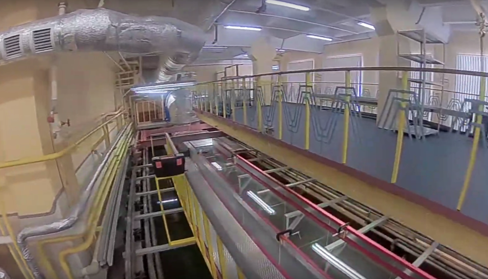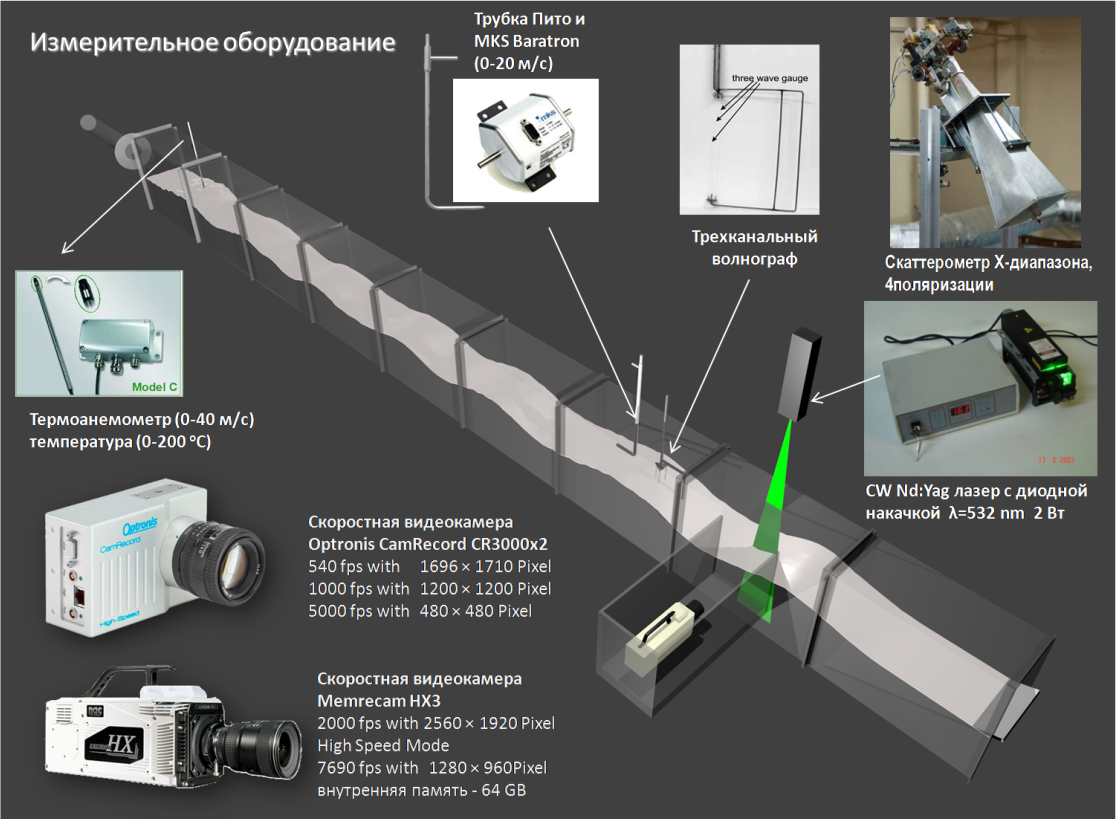
Ветроволновой большой опытовый термостратифицированный бассейн
Основой Гидрофизического комплекса ИПФ РАН является Ветроволновой большой опытовый термостратифицированный бассейн (ВБОТСБ). Это уникальный экспериментальный стенд, обеспечивающий лабораторное моделирование гидрофизических процессов в приповерхностном слое океана, приводном слое атмосферы, а также ветроволновое взаимодействие в широком диапазоне условий. Его основной особенностью является возможность создания и долговременного поддержания температурной стратификации воды по глубине, которая в значительной мере определяет процессы, протекающие в морях и океанах. Также обеспечена возможность моделирования экстремальных условий на границе атмосферы и гидросферы - штормов и ураганов.
На установке выполняются исследования по следующим направлениям:
- изучение процессов в деятельном слое океана, включая природные явления и антропогенные воздействия;
- лабораторное моделирование взаимодействия атмосферы и гидросферы в широком диапазоне условий, включая экстремальные;
- дистанционная диагностика взволнованной водной поверхности;
- испытания измерительных средств метеорологической и гидрологической обстановки.
В состав ВВТСБ входят:
- Большой опытовый термостратифицированный бассейн (БОСБ);
- Высокоскоростной ветроволновой канал (ВВК).
ВВТСБ оборудован буксировочными тележками, волнопродукторами поверхностных и внутренних гравитационных волн. На нём размещён уникальный измерительный комплекс, включающий в себя различные средства контактных измерений, а также оригинальные лазерно-оптические системы для визуализации течений. Комплекс автоматизирован и включает в себя средства прецизионного позиционирования приборов с помощью шаговых двигателей.
На сегодняшний день по степени приближения к параметрам температурной стратификации в приповерхностном водном слое в реальных условиях (включая перепад температуры, частоту плавучести и объемы воды, в которых реализовано температурное расслоение) ВВТСБ не имеет аналогов ни в Российской Федерации ни за рубежом.
Действующими аналогами по моделированию ветроволнового взаимодействия являются всего лишь несколько зарубежных экспериментальных установок, включая канал LASIF (Франция), кольцевой канал AELOTRON (Германия) и недавно построенный крупнейший в мире бассейн SUSTAIN (США).

Большой опытовый термостратифицированный бассейн
Большой опытовый термостратифицированный бассейн (БОСБ) является крупнейшим в мире гидрофизическим стендом, в котором реализована возможность создания стратификации – неоднородного по вертикали распределения температуры. Уникальная система, включающая в себя три мощных холодильных машины, работает по типу теплового насоса, забирая тепло у нижнего слоя воды, и передавая его верхнему слою. Приблизительно за 20 часов непрерывной работы в однородно перемешанной толще воды температурой 15 градусов достигается стратификация термоклинного типа с разностью температур от 27 градусов на поверхности до 6 градусов на дне, с резким скачком плотности на глубине около 60 сантиметров. Эти уникальные условия позволяют исследовать динамику внутренних волн, их проявления в поле поверхностных волн, изучать эволюцию турбулентных течений в условиях стратификации. Бассейн оборудован буксировочной тележкой для исследования течений за телами и позиционирования средств измерений, а также волнопродукторами поверхностных и внутренних гравитационных волн. Волнопродуктор поверхностных волн использует цилиндры различного диаметра, осциллирующие на поверхности воды в вертикальном направлении. Волнопродуктор внутренних волн представляет собой вертикальную пластину, совершающую угловые колебания относительно горизонтальной оси на уровне центра термоклина.
Технические параметры
- Размеры – 20 м × 4 м × 2 м
- Мощность холодильных машин – 150 кВт
- Создаваемая разность температур между дном и поверхностью – до 21°С
- Глубина расположения скачка температуры (термоклина) – 0.6 м
- Максимальное значение частоты плавучести – 0.3 рад/с
- Cкорость движения буксировочной тележки – 0.02 … 1.0 м/с
- Диаметр цилиндров волнопродуктора поверхностных волн – 5, 10, 16 мм
- Частота волнопродуктора поверхностных волн – 1 … 4 Гц
- Амплитуда вертикальных колебаний волнопродуктора – до 5 см
- Размеры пластины волнопродуктора внутренних волн – 3.5 × 0.7 м
- Частота волнопродуктора внутренних волн – 0.008 … 0.05 Гц
- Амплитуда внутренних волн – 0.1 … 4 см

Высокоскоростной ветроволновой канал
Высокоскоростной ветроволновой канал (ВВК) предназначен для моделирования эффектов взаимодействия воздушных потоков атмосферы с морской поверхностью в широком диапазоне условий, включая экстремальные: шторма и ураганы. Канал расположен посередине БОСБ; его длина 12 м, ширина аэродинамического канала 0.7 м, высота линенйно увеличивается от 0.7 м на входе до 0.9 м на выходе. Благодаря увеличению сечения в канале удалось реализовать безнапорный поток по аналогии с натурными условиями. Боковые стенки канала заглублены в воду на 40 см, дно отсутствует. Установка канала непосредственно в чашу БОСБ с большим внешним объемом воды предупреждает подводное противотечение, компенсирующее ветровой нагон. Эта особенность выгодно отличает ВВК от ветроволновых каналов стандартной конструкции, для которых характерен указанный недостаток. Аэродинамический тракт оснащен поворотными направляющими лопатками на изгибах, а также шумогасителем; перед выходом на водную поверхность установлена расширяюще-сужающая секция с набором хонейкомбов. Все эти системы гарантируют высокое качество воздушного потока на входе в канал с уровнем флуктуаций порядка 1% и высокой степенью однородности потока по сечению. Канал оснащен специальной системой плавной контролируемой перестройки частоты вращения нагнетающего центробежного вентилятора, подающего воздух в аэродинамический тракт. Таким образом, возможна плавная регулировка скорости ветра на оси канала в диапазоне до 25 м/с, что в пересчете на эквивалентную скорость на высоте 10 м для натурных условий соответствует скоростям до 40 м/с. При таких скоростях в лабораторных условиях удается реализовать режим регулярного обрушения волн с образованием пенных гребней и брызг. В канале реализована возможность контролируемого перемешивания воздуха, забираемого с улицы и из рабочего помещения, с целью регулировки температуры и объемного расхода. В результате температура воздушного потока на входе в канал регулируется в диапазоне от -2°С до +45°С, в зависимости от режима работы и времени года. В сочетании с возможностью управления температурой приповерхностного слоя воды в диапазоне от +5°С до +25°С, это позволяет выполнять исследования процессов ветроволнового взаимодействия в широком диапазоне перепадов температур между водой и воздухом в канале, характерных, в частности, для экстремальных условий полярных областей.
Технические параметры
- Размеры прямой части воздушного канала над водной поверхностью – длина 12 м сечение от 0.7 м × 0.7 м до 0.7 м × 0.9 м
- Скорость ветра на оси канала в рабочей секции – 0 … 25 м/с
- Температура воздушного потока в канале – -2°С … +45°С
- Температура поверхности воды в канале – +5°С … +25°С
- Частота волнопродуктора поверхностных волн – 1 … 2.5 Гц
- Амплитуда вертикальных колебаний волнопродуктора – до до 5 см
Измерительное оборудование Гидрокомплекса
